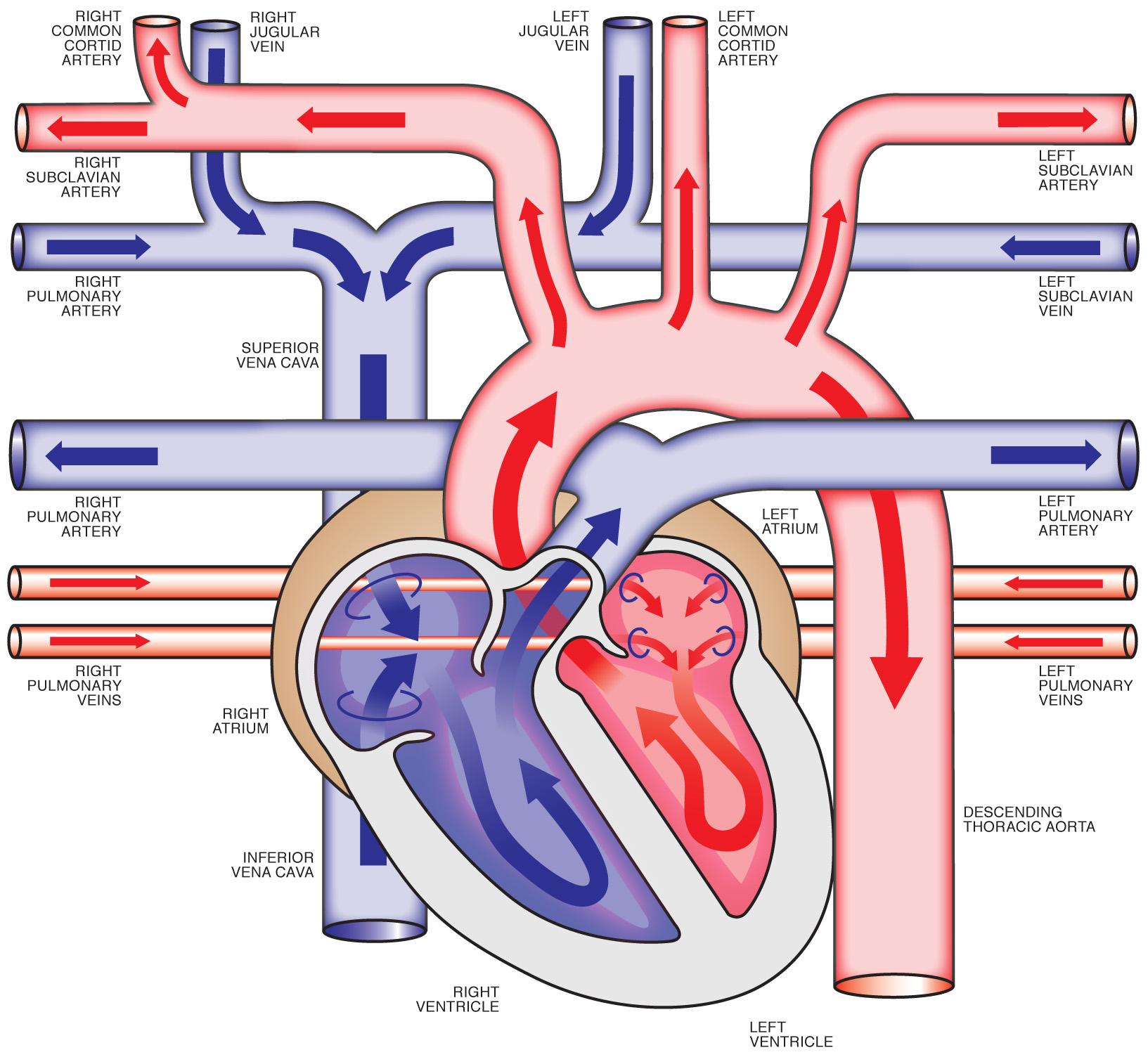Unidirectional Blood Flow Chart Your left atrium receives oxygenated blood from the lungs which is then pumped into the left ventricle from where it moves into the aorta and then to the different parts of your body Valves to Ensure Unidirectional Blood Flow Your heart has four types of valves with primary function of regulating the blood flow through the heart Every heart
Learn all about the heart blood vessels and composition of blood itself with our 3D models and explanations of cardiovascular system anatomy and physiology The cardiovascular system consists of the heart blood vessels and the approximately 5 liters of blood that the blood vessels transport This chart shows the hierarchical percentages of blood flow found within each circuit of blood flow inner ring within the arteries capillaries and veins of each circuit middle ring and within each specific type of systemic vessel outer ring The same data used to create this graphic are given in Table PageIndex 3 Image credit
Unidirectional Blood Flow Chart

Unidirectional Blood Flow Chart
https://www.edinformatics.com/math_science/path-blood-takes.jpg

Pulmonary Valve Structure a Unidirectional Blood Flow Through The Download Scientific
https://www.researchgate.net/publication/368940833/figure/fig1/AS:11431281158975975@1684255473753/Pulmonary-valve-structure-a-Unidirectional-blood-flow-through-the-heart-is-facilitated_Q640.jpg

Pulmonary Valve Structure a Unidirectional Blood Flow Through The Download Scientific
https://www.researchgate.net/publication/368940833/figure/fig2/AS:11431281158930209@1684255475579/Pulmonary-valve-function-a-Pressure-profiles-in-the-right-ventricle-and-pulmonary_Q640.jpg
Each of the major pumping chambers of the heart ejects approximately 70 mL blood per contraction in a resting adult This would be equal to 5 25 litres of fluid per minute and approximately 14 000 litres per day Here is the step by step flow of blood including the chambers and valves Deoxygenated blood from the body flows to the heart via the superior vena cava and inferior vena cava The lungs receive deoxygenated blood from the pulmonary arteries and return oxygenated blood to the heart via the pulmonary veins
This video provides a simple step by step diagram of the cardiac blood flow and a chart of the circulation pathway Includes the anatomy of the heart and an animation quiz at the end in order to test your knowledge Internally the heart is divided into four chambers through which blood flows Blood flows in just one direction through the chambers due to heart valves As shown in Figure 10 3 3 10 3 3 the wall of the heart is made up of three layers called the endocardium myocardium and pericardium The endocardium is the innermost layer of the heart wall
More picture related to Unidirectional Blood Flow Chart
1 Which Can Be Used To Describe Blood Flow In The Chegg
https://media.cheggcdn.com/study/7dd/7dd9ac32-1ae8-4bdb-96b5-c5f622def295/image

Master React Unidirectional Data Flow CoderPad
https://d2h1bfu6zrdxog.cloudfront.net/wp-content/uploads/2021/04/img_6088a07a0be12.png
Solved Which Of The Following Structures Helps To Regulate Chegg
https://media.cheggcdn.com/study/1a5/1a5b3be1-11cc-4b29-9dd1-6f58856b4b6e/image
Key anatomical structures are labelled and the flow of electrical activity is illustrated by the white arrows When looking at this diagram take note that the left ventricle of the heart is much bigger and more muscular than the right because it has the hard job of pumping the oxygenated blood through the aorta to the rest of the body The heart is comprised of four chambers the right atrium right ventricle left atrium and left ventricle Blood circulates through these chambers via a series of valves that ensure unidirectional flow and prevent backflow This chapter provides a very basic overview of
Start studying Blood flow figure 8 chart Learn vocabulary terms and more with flashcards games and other study tools Draw a flow chart showing the components of the cardiovascular system Start with the three main components heart blood vessels and blood and continue by specifying all the constituent parts of each Compare and contrast clearly the anatomical structure and function of arteries veins and blood capillaries

Normal Blood Circulation Flow Chart
https://1.bp.blogspot.com/-cYvvvbmfb1E/XRHSvqPJLWI/AAAAAAAAD08/dKGgkJ5AzJ4FmbAOXNkgW6FNTQwT5AdfQCEwYBhgL/s1600/normal%2Bbc%2Bpic.jpg

Unidirectional Process Flow Diagram Flat Powerpoint Design PowerPoint Slide Templates Download
https://www.slideteam.net/media/catalog/product/cache/960x720/u/n/unidirectional_process_flow_diagram_flat_powerpoint_design_Slide02.jpg

https://www.newhealthadvisor.org › Heart-Diagram-Labeled.html
Your left atrium receives oxygenated blood from the lungs which is then pumped into the left ventricle from where it moves into the aorta and then to the different parts of your body Valves to Ensure Unidirectional Blood Flow Your heart has four types of valves with primary function of regulating the blood flow through the heart Every heart

https://www.innerbody.com › image › cardov
Learn all about the heart blood vessels and composition of blood itself with our 3D models and explanations of cardiovascular system anatomy and physiology The cardiovascular system consists of the heart blood vessels and the approximately 5 liters of blood that the blood vessels transport

PPT Heart Functions Of The Heart Ensures Unidirectional Flow Of Blood Pumps Blood To Lungs

Normal Blood Circulation Flow Chart

The Boundary Conditions For Unidirectional Flow Configuration Download Scientific Diagram

Information Flow Chart Office Document Curve Business Flow Chart Vector Information Flow Chart

Heart Blood Flow Simple Anatomy Diagram Cardiac 43 OFF

Printable Blood Flow Through The Heart Diagram Bmp point

Printable Blood Flow Through The Heart Diagram Bmp point
Steps Of Blood Flow Through The Heart

Lymph Circulation Flow Chart Flowchart Examples Images And Photos Finder

Blood Flow In The Heart MCAT Biology MedSchoolCoach
Unidirectional Blood Flow Chart - Internally the heart is divided into four chambers through which blood flows Blood flows in just one direction through the chambers due to heart valves As shown in Figure 10 3 3 10 3 3 the wall of the heart is made up of three layers called the endocardium myocardium and pericardium The endocardium is the innermost layer of the heart wall

